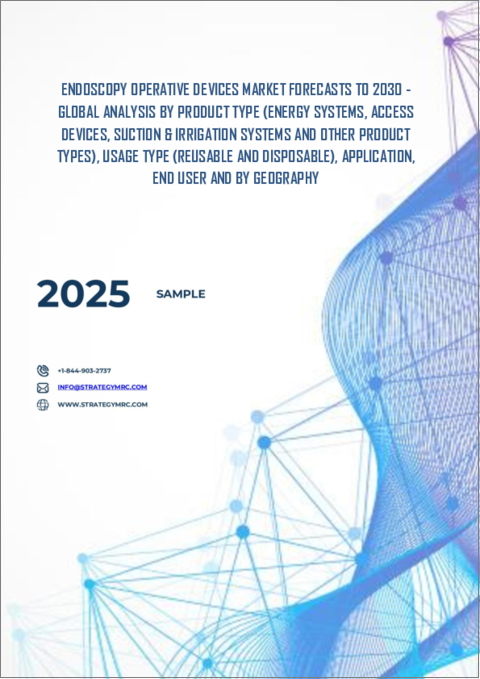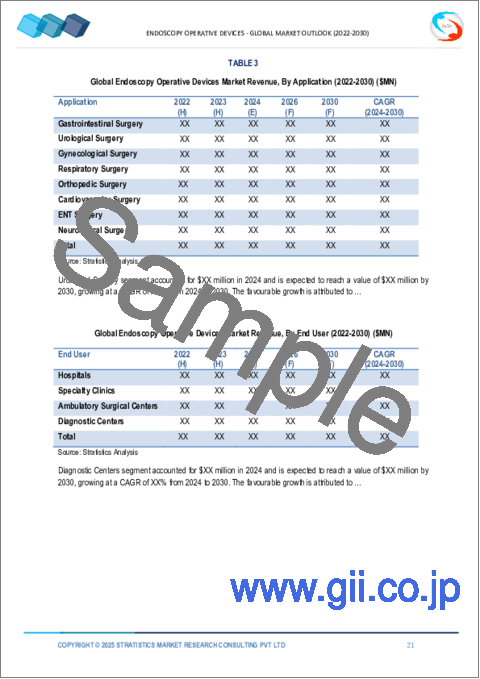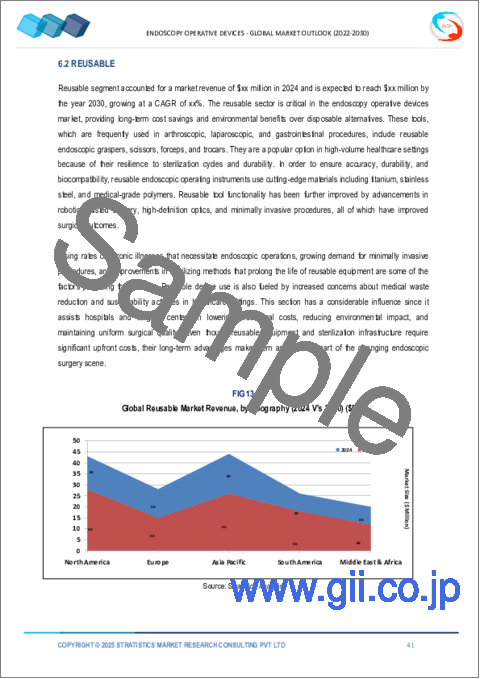|
|
市場調査レポート
商品コード
1625225
内視鏡手術機器市場の2030年までの予測:製品タイプ、使用タイプ、用途、エンドユーザー、地域別の世界分析Endoscopy Operative Devices Market Forecasts to 2030 - Global Analysis By Product Type (Energy Systems, Access Devices, Suction & Irrigation Systems and Other Product Types), Usage Type (Reusable and Disposable), Application, End User and By Geography |
||||||
カスタマイズ可能
|
|||||||
| 内視鏡手術機器市場の2030年までの予測:製品タイプ、使用タイプ、用途、エンドユーザー、地域別の世界分析 |
|
出版日: 2025年01月01日
発行: Stratistics Market Research Consulting
ページ情報: 英文 200+ Pages
納期: 2~3営業日
|
全表示
- 概要
- 図表
- 目次
Stratistics MRCによると、世界の内視鏡手術機器市場は2024年に109億米ドルを占め、予測期間中のCAGRは6.1%で成長し、2030年には155億米ドルに達する見込みです。
内視鏡手術機器は、内視鏡手術中に臓器や空洞の状態を診断、治療、モニタリングするための専用ツールです。これらの器具には、鉗子、ハサミ、スネア、把持器、力ベースの器具などがあり、貫通性は低いです。これらの器具は、消化器外科、リウマチ科、婦人科などの領域で使用され、手術効率を向上させ、患者の回復時間を短縮し、手術のリスクを軽減します。人間工学に基づいた高度な設計と機能により、特定の医療ニーズに対応し、現代の内科診療に適しています。
内視鏡機器の絶え間ない革新
内視鏡検査機器における継続的な技術革新は市場の主要な促進要因であり、メーカー各社は画像品質と機器の操作性を向上させる先進技術の統合に注力しています。これらの技術革新は、回復時間の短縮や合併症リスクの低減といった利点をもたらす低侵襲手技を可能にします。研究開発に投資することで、企業は医療従事者や患者の進化するニーズに対応する新機能を導入し、それによって患者の予後を改善し、さまざまな医療専門分野に市場の裾野を広げています。
中枢神経系と感染症のリスク
内視鏡処置に伴う感染症のリスクは、市場の大きな抑制要因です。ERCPのような処置は、不完全な胆道ドレナージや汚染された器具などの要因により感染症につながる可能性があります。このリスクにより厳格な感染管理対策が必要となり、ヘルスケアプロバイダーの運営コストと複雑さを増大させる可能性があります。また、感染リスクに対する懸念から、内視鏡手術を受けることをためらう患者もおり、機器技術の進歩にもかかわらず、市場の成長を制限する可能性があります。
低侵襲性への需要の高まり
低侵襲手術に対する需要の高まりは、内視鏡手術機器市場にとって大きな機会となります。低侵襲手術は、術後の痛みの軽減、回復の早さ、入院期間の短縮など数多くのメリットをもたらします。このような利点に対する認識が患者やヘルスケアプロバイダーの間で高まるにつれて、内視鏡ソリューションに対する需要が増加しています。この動向は、手技の効率と患者の転帰を向上させる技術の進歩によってさらに後押しされ、市場の拡大を後押ししています。
厳しい規制当局の承認
厳しい規制承認が内視鏡手術機器市場に脅威を与えています。FDAのような規制機関は、製品開発や市場開拓を遅らせる可能性のある厳格な安全・品質基準を課しています。これらの規制を遵守するには多大な時間とリソースを必要とするため、メーカーにとっては技術革新の妨げとなり、コスト増となる可能性があります。このような課題は、新製品のイントロダクションを制限し、特に規制に関する幅広い専門知識を持たない中小企業にとっては、市場の成長を鈍らせる可能性があります。
COVID-19の影響:
COVID-19のパンデミックは、当初、選択的手術の延期とCOVID-19症例の管理にリソースを振り向けたため、内視鏡手術機器市場を混乱させました。このため需要は一時的に減少しました。しかし、ヘルスケアシステムが適応するにつれて、再延期された治療や、効率と感染制御の改善を目的とした機器技術の革新によって、内視鏡手術の需要が回復しました。
予測期間中、再利用可能な手術器具セグメントが最大となる見込み
再利用可能な手術器具セグメントは、その費用対効果と耐久性により、予測期間中に最大の市場シェアを占めると予想されます。これらの器具は、性能を維持しながら何度もの滅菌に耐えることができるため、ヘルスケアプロバイダーに支持されています。低侵襲手術に対する需要の高まりは、このセグメントの優位性をさらに高めています。再利用可能な器具は、複雑な手術の際に視覚化と操作性を向上させるからです。
消化器外科分野は予測期間中最も高いCAGRが見込まれる
予測期間中、消化器外科分野は最も高いCAGRが見込まれます。この成長の原動力は、世界の消化器疾患の有病率の増加です。内視鏡ツールの技術的進歩は診断精度と治療成果を高め、これらの手技をより魅力的なものにしています。新興市場のヘルスケアインフラが改善するにつれて、消化器内視鏡検査の採用は大幅に増加すると予想されます。
最大のシェアを占める地域:
北米地域は、医療インフラが進んでおり、内視鏡的介入を必要とする慢性疾患の有病率が高いことから、予測期間中に最大の市場シェアを占めると予想されます。革新的なソリューションに投資する主要市場企業の存在が北米の地位をさらに強化しています。有利な償還政策も先進的内視鏡技術の普及を支えています。
CAGRが最も高い地域:
アジア太平洋地域は、先進技術の採用が増加していること、高齢者人口が増加していることから、予測期間中に最も高い成長率を記録すると予測されています。低侵襲手技に対する意識の高まりとヘルスケアインフラの改善がこの成長に寄与しています。効果的な診断・治療ソリューションへの需要が高まるにつれ、アジア太平洋地域は世界市場において重要な成長地域として浮上しています。
無料カスタマイズサービス:
本レポートをご購読のお客様には、以下の無料カスタマイズオプションのいずれかをご利用いただけます:
- 企業プロファイル
- 追加市場企業の包括的プロファイリング(3社まで)
- 主要企業のSWOT分析(3社まで)
- 地域セグメンテーション
- 顧客の関心に応じた主要国の市場推計・予測・CAGR(注:フィージビリティチェックによる)
- 競合ベンチマーキング
- 製品ポートフォリオ、地理的プレゼンス、戦略的提携に基づく主要企業のベンチマーキング
目次
第1章 エグゼクティブサマリー
第2章 序文
- 概要
- ステークホルダー
- 調査範囲
- 調査手法
- データマイニング
- データ分析
- データ検証
- 調査アプローチ
- 調査情報源
- 1次調査情報源
- 2次調査情報源
- 前提条件
第3章 市場動向分析
- 促進要因
- 抑制要因
- 機会
- 脅威
- 製品分析
- 用途分析
- エンドユーザー分析
- 新興市場
- COVID-19の影響
第4章 ポーターのファイブフォース分析
- 供給企業の交渉力
- 買い手の交渉力
- 代替品の脅威
- 新規参入業者の脅威
- 競争企業間の敵対関係
第5章 世界の内視鏡手術機器市場:製品タイプ別
- エネルギーシステム
- 無線周波数デバイス
- 超音波装置
- レーザーシステム
- 電気外科ユニット
- アクセスデバイス
- トロカール
- 吸入針
- アクセスポート
- 吸引・灌流システム
- 手用器具
- グラスパー
- はさみ
- 鉗子
- 解剖学
- 閉鎖装置
- クリップ
- ホッチキス
- 創傷開創器
- スネアと摘出機器
第6章 世界の内視鏡手術機器市場:使用タイプ別
- 再利用可能
- 使い捨て
第7章 世界の内視鏡手術機器市場:用途別
- 消化器外科
- 泌尿器科手術
- 婦人科手術
- 呼吸器外科
- 整形外科
- 心臓血管外科
- 耳鼻咽喉科手術
- 神経外科
第8章 世界の内視鏡手術機器市場:エンドユーザー別
- 病院
- 専門クリニック
- 外来手術センター
- 診断センター
第9章 世界の内視鏡手術機器市場:地域別
- 北米
- 米国
- カナダ
- メキシコ
- 欧州
- ドイツ
- 英国
- イタリア
- フランス
- スペイン
- その他欧州
- アジア太平洋
- 日本
- 中国
- インド
- オーストラリア
- ニュージーランド
- 韓国
- その他アジア太平洋地域
- 南米
- アルゼンチン
- ブラジル
- チリ
- その他南米
- 中東・アフリカ
- サウジアラビア
- アラブ首長国連邦
- カタール
- 南アフリカ
- その他中東とアフリカ
第10章 主な発展
- 契約、パートナーシップ、コラボレーション、合弁事業
- 買収と合併
- 新製品発売
- 事業拡大
- その他の主要戦略
第11章 企業プロファイリング
- Olympus Corporation
- Boston Scientific Corporation
- Stryker Corporation
- KARL STORZ GmbH & Co. KG
- FUJIFILM Holdings Corporation
- Smith & Nephew PLC
- Ethicon Endo-Surgery
- B. Braun Melsungen AG
- Cook Medical, Inc.
- Intuitive Surgical, Inc.
- Medtronic PLC
- Hoya Corporation
- Richard Wolf GmbH
- Arthrex, Inc.
- ConMed Corporation
- Ambu A/S
- Cantel Medical
- Hillrom
List of Tables
- Table 1 Global Endoscopy Operative Devices Market Outlook, By Region (2022-2030) ($MN)
- Table 2 Global Endoscopy Operative Devices Market Outlook, By Product Type (2022-2030) ($MN)
- Table 3 Global Endoscopy Operative Devices Market Outlook, By Energy Systems (2022-2030) ($MN)
- Table 4 Global Endoscopy Operative Devices Market Outlook, By Radiofrequency Devices (2022-2030) ($MN)
- Table 5 Global Endoscopy Operative Devices Market Outlook, By Ultrasonic Devices (2022-2030) ($MN)
- Table 6 Global Endoscopy Operative Devices Market Outlook, By Laser Systems (2022-2030) ($MN)
- Table 7 Global Endoscopy Operative Devices Market Outlook, By Electrosurgical Units (2022-2030) ($MN)
- Table 8 Global Endoscopy Operative Devices Market Outlook, By Access Devices (2022-2030) ($MN)
- Table 9 Global Endoscopy Operative Devices Market Outlook, By Trocars (2022-2030) ($MN)
- Table 10 Global Endoscopy Operative Devices Market Outlook, By Insufflation Needles (2022-2030) ($MN)
- Table 11 Global Endoscopy Operative Devices Market Outlook, By Access Ports (2022-2030) ($MN)
- Table 12 Global Endoscopy Operative Devices Market Outlook, By Suction & Irrigation Systems (2022-2030) ($MN)
- Table 13 Global Endoscopy Operative Devices Market Outlook, By Hand Instruments (2022-2030) ($MN)
- Table 14 Global Endoscopy Operative Devices Market Outlook, By Graspers (2022-2030) ($MN)
- Table 15 Global Endoscopy Operative Devices Market Outlook, By Scissors (2022-2030) ($MN)
- Table 16 Global Endoscopy Operative Devices Market Outlook, By Forceps (2022-2030) ($MN)
- Table 17 Global Endoscopy Operative Devices Market Outlook, By Dissectors (2022-2030) ($MN)
- Table 18 Global Endoscopy Operative Devices Market Outlook, By Closure Devices (2022-2030) ($MN)
- Table 19 Global Endoscopy Operative Devices Market Outlook, By Clips (2022-2030) ($MN)
- Table 20 Global Endoscopy Operative Devices Market Outlook, By Staplers (2022-2030) ($MN)
- Table 21 Global Endoscopy Operative Devices Market Outlook, By Wound Retractors (2022-2030) ($MN)
- Table 22 Global Endoscopy Operative Devices Market Outlook, By Snares & Retrieval Devices (2022-2030) ($MN)
- Table 23 Global Endoscopy Operative Devices Market Outlook, By Usage Type (2022-2030) ($MN)
- Table 24 Global Endoscopy Operative Devices Market Outlook, By Reusable (2022-2030) ($MN)
- Table 25 Global Endoscopy Operative Devices Market Outlook, By Disposable (2022-2030) ($MN)
- Table 26 Global Endoscopy Operative Devices Market Outlook, By Application (2022-2030) ($MN)
- Table 27 Global Endoscopy Operative Devices Market Outlook, By Gastrointestinal Surgery (2022-2030) ($MN)
- Table 28 Global Endoscopy Operative Devices Market Outlook, By Urological Surgery (2022-2030) ($MN)
- Table 29 Global Endoscopy Operative Devices Market Outlook, By Gynecological Surgery (2022-2030) ($MN)
- Table 30 Global Endoscopy Operative Devices Market Outlook, By Respiratory Surgery (2022-2030) ($MN)
- Table 31 Global Endoscopy Operative Devices Market Outlook, By Orthopedic Surgery (2022-2030) ($MN)
- Table 32 Global Endoscopy Operative Devices Market Outlook, By Cardiovascular Surgery (2022-2030) ($MN)
- Table 33 Global Endoscopy Operative Devices Market Outlook, By ENT Surgery (2022-2030) ($MN)
- Table 34 Global Endoscopy Operative Devices Market Outlook, By Neurological Surgery (2022-2030) ($MN)
- Table 35 Global Endoscopy Operative Devices Market Outlook, By End User (2022-2030) ($MN)
- Table 36 Global Endoscopy Operative Devices Market Outlook, By Hospitals (2022-2030) ($MN)
- Table 37 Global Endoscopy Operative Devices Market Outlook, By Specialty Clinics (2022-2030) ($MN)
- Table 38 Global Endoscopy Operative Devices Market Outlook, By Ambulatory Surgical Centers (2022-2030) ($MN)
- Table 39 Global Endoscopy Operative Devices Market Outlook, By Diagnostic Centers (2022-2030) ($MN)
Note: Tables for North America, Europe, APAC, South America, and Middle East & Africa Regions are also represented in the same manner as above.
According to Stratistics MRC, the Global Endoscopy Operative Devices Market is accounted for $10.9 billion in 2024 and is expected to reach $15.5 billion by 2030 growing at a CAGR of 6.1% during the forecast period. Endoscopic surgical devices are specialized tools for diagnosing, treating, or monitoring conditions in organs and cavities during endoscopic surgery. These devices include forceps, scissors, snares, graspers, and force-based devices, which are less penetrating. Techniques are designed to perform specific surgical tasks when used in areas such as gastroenterology, rheumatology, and gynecology; they improve surgical efficiency, reduce patient recovery time, and reduce surgical risks. Their advanced ergonomic design and function meet specific medical needs, making them relevant in modern internal medicine practice.
Market Dynamics:
Driver:
Continuous innovation in endoscopy devices
Continuous innovation in endoscopy devices is a key driver for the market, as manufacturers focus on integrating advanced technologies to enhance imaging quality and device maneuverability. These innovations enable minimally invasive procedures, which offer benefits such as reduced recovery times and lower risks of complications. By investing in research and development, companies introduce new capabilities that meet the evolving needs of healthcare providers and patients, thereby improving patient outcomes and expanding the market's reach across various medical specialties.
Restraint:
Risk of CNS and infections
The risk of infections associated with endoscopic procedures is a significant restraint on the market. Procedures like ERCP can lead to infections due to factors such as incomplete biliary drainage and contaminated equipment. This risk necessitates stringent infection control measures, which can increase operational costs and complexity for healthcare providers. Concerns about infection risks may also deter some patients from undergoing endoscopic procedures, potentially limiting market growth despite advancements in device technology.
Opportunity:
Rising demand for minimally invasive
The rising demand for minimally invasive procedures presents a significant opportunity for the endoscopy operative devices market. These procedures offer numerous advantages, including less postoperative pain, quicker recovery, and reduced hospital stays. As awareness of these benefits grows among patients and healthcare providers, the demand for endoscopic solutions increases. This trend is further supported by technological advancements that enhance procedural efficiency and patient outcomes, driving market expansion.
Threat:
Stringent regulatory approvals
Stringent regulatory approvals pose a threat to the endoscopy operative devices market. Regulatory bodies like the FDA impose rigorous safety and quality standards that can delay product development and market entry. Compliance with these regulations requires significant time and resources, potentially hindering innovation and increasing costs for manufacturers. These challenges can limit the introduction of new products and slow market growth, particularly for smaller companies lacking extensive regulatory expertise.
Covid-19 Impact:
The COVID-19 pandemic initially disrupted the endoscopy operative devices market due to postponed elective procedures and resource diversion towards managing COVID-19 cases. This led to a temporary decline in demand. However, as healthcare systems adapted, there was a rebound in demand for endoscopic procedures, driven by rescheduled treatments and innovations in device technology aimed at improving efficiency and infection control.
The reusable operative devices segment is expected to be the largest during the forecast period
The reusable operative devices segment is expected to account for the largest market share during the forecast period due to their cost-effectiveness and durability. These devices are favored by healthcare providers for their ability to withstand multiple sterilizations while maintaining performance. The growing demand for minimally invasive surgeries further drives this segment's dominance, as reusable devices offer enhanced visualization and maneuverability during complex procedures.
The gastrointestinal surgery segment is expected to have the highest CAGR during the forecast period
Over the forecast period, the gastrointestinal surgery segment is expected to witness the highest CAGR. This growth is driven by the increasing prevalence of gastrointestinal disorders globally. Technological advancements in endoscopic tools enhance diagnostic accuracy and therapeutic outcomes, making these procedures more appealing. As healthcare infrastructure improves in emerging markets, the adoption of gastrointestinal endoscopy is expected to rise significantly.
Region with largest share:
The North America region is anticipated to account for the largest market share during the forecast period due to its advanced healthcare infrastructure and high prevalence of chronic diseases requiring endoscopic intervention. The presence of key market players investing in innovative solutions further strengthens North America's position. Favorable reimbursement policies also support widespread adoption of advanced endoscopic technologies.
Region with highest CAGR:
The Asia Pacific region is anticipated to register the highest growth rate over the forecast period due to increasing adoption of advanced technologies and a growing geriatric population. Rising awareness about minimally invasive procedures and improvements in healthcare infrastructure contribute to this growth. As demand for effective diagnostic and therapeutic solutions increases, Asia Pacific emerges as a key growth region in the global market landscape.
Key players in the market
Some of the key players in Endoscopy Operative Devices Market include Olympus Corporation, Boston Scientific Corporation, Stryker Corporation, KARL STORZ GmbH & Co. KG, FUJIFILM Holdings Corporation, Smith & Nephew PLC, Ethicon Endo-Surgery, B. Braun Melsungen AG, Cook Medical, Inc., Intuitive Surgical, Inc., Medtronic PLC, Hoya Corporation, Richard Wolf GmbH, Arthrex, Inc., ConMed Corporation, Ambu A/S, Cantel Medical and Hillrom.
Key Developments:
In October 2024, Olympus announces CE approval for three cloud-based AI medical devices, enhancing clinical outcomes and operational efficiency in endoscopy, with plans for an AI-powered endoscopy ecosystem in 2025.
In October 2023, B. Braun launches its newest laparoscopic AESCULAP(R) EinsteinVision(R) 3.0 FI during International Society for Gynecologic Endoscopy (ISGE) Annual Meeting 2023 at Sanur, Bali. This latest version is equipped with 3D Fluorescence Imaging that enables imaging in real time through its three different FI overlay modes.
In February 2023, KARL STORZ announces the acquisition of 100 percent of the shares of AventaMed DAC, an Irish medical technologies company, enhancing its ENT portfolio with a breakthrough single-use medical device for tympanostomy procedures.
Product Types Covered:
- Energy Systems
- Access Devices
- Suction & Irrigation Systems
- Hand Instruments
- Closure Devices
- Wound Retractors
- Snares & Retrieval Devices
Usage Types Covered:
- Reusable
- Disposable
Applications Covered:
- Gastrointestinal Surgery
- Urological Surgery
- Gynecological Surgery
- Respiratory Surgery
- Orthopedic Surgery
- Cardiovascular Surgery
- ENT Surgery
- Neurological Surgery
End Users Covered:
- Hospitals
- Specialty Clinics
- Ambulatory Surgical Centers
- Diagnostic Centers
Regions Covered:
- North America
- US
- Canada
- Mexico
- Europe
- Germany
- UK
- Italy
- France
- Spain
- Rest of Europe
- Asia Pacific
- Japan
- China
- India
- Australia
- New Zealand
- South Korea
- Rest of Asia Pacific
- South America
- Argentina
- Brazil
- Chile
- Rest of South America
- Middle East & Africa
- Saudi Arabia
- UAE
- Qatar
- South Africa
- Rest of Middle East & Africa
What our report offers:
- Market share assessments for the regional and country-level segments
- Strategic recommendations for the new entrants
- Covers Market data for the years 2022, 2023, 2024, 2026, and 2030
- Market Trends (Drivers, Constraints, Opportunities, Threats, Challenges, Investment Opportunities, and recommendations)
- Strategic recommendations in key business segments based on the market estimations
- Competitive landscaping mapping the key common trends
- Company profiling with detailed strategies, financials, and recent developments
- Supply chain trends mapping the latest technological advancements
Free Customization Offerings:
All the customers of this report will be entitled to receive one of the following free customization options:
- Company Profiling
- Comprehensive profiling of additional market players (up to 3)
- SWOT Analysis of key players (up to 3)
- Regional Segmentation
- Market estimations, Forecasts and CAGR of any prominent country as per the client's interest (Note: Depends on feasibility check)
- Competitive Benchmarking
- Benchmarking of key players based on product portfolio, geographical presence, and strategic alliances
Table of Contents
1 Executive Summary
2 Preface
- 2.1 Abstract
- 2.2 Stake Holders
- 2.3 Research Scope
- 2.4 Research Methodology
- 2.4.1 Data Mining
- 2.4.2 Data Analysis
- 2.4.3 Data Validation
- 2.4.4 Research Approach
- 2.5 Research Sources
- 2.5.1 Primary Research Sources
- 2.5.2 Secondary Research Sources
- 2.5.3 Assumptions
3 Market Trend Analysis
- 3.1 Introduction
- 3.2 Drivers
- 3.3 Restraints
- 3.4 Opportunities
- 3.5 Threats
- 3.6 Product Analysis
- 3.7 Application Analysis
- 3.8 End User Analysis
- 3.9 Emerging Markets
- 3.10 Impact of Covid-19
4 Porters Five Force Analysis
- 4.1 Bargaining power of suppliers
- 4.2 Bargaining power of buyers
- 4.3 Threat of substitutes
- 4.4 Threat of new entrants
- 4.5 Competitive rivalry
5 Global Endoscopy Operative Devices Market, By Product Type
- 5.1 Introduction
- 5.2 Energy Systems
- 5.2.1 Radiofrequency Devices
- 5.2.2 Ultrasonic Devices
- 5.2.3 Laser Systems
- 5.2.4 Electrosurgical Units
- 5.3 Access Devices
- 5.3.1 Trocars
- 5.3.2 Insufflation Needles
- 5.3.3 Access Ports
- 5.4 Suction & Irrigation Systems
- 5.5 Hand Instruments
- 5.5.1 Graspers
- 5.5.2 Scissors
- 5.5.3 Forceps
- 5.5.4 Dissectors
- 5.6 Closure Devices
- 5.6.1 Clips
- 5.6.2 Staplers
- 5.7 Wound Retractors
- 5.8 Snares & Retrieval Devices
6 Global Endoscopy Operative Devices Market, By Usage Type
- 6.1 Introduction
- 6.2 Reusable
- 6.3 Disposable
7 Global Endoscopy Operative Devices Market, By Application
- 7.1 Introduction
- 7.2 Gastrointestinal Surgery
- 7.3 Urological Surgery
- 7.4 Gynecological Surgery
- 7.5 Respiratory Surgery
- 7.6 Orthopedic Surgery
- 7.7 Cardiovascular Surgery
- 7.8 ENT Surgery
- 7.9 Neurological Surgery
8 Global Endoscopy Operative Devices Market, By End User
- 8.1 Introduction
- 8.2 Hospitals
- 8.3 Specialty Clinics
- 8.4 Ambulatory Surgical Centers
- 8.5 Diagnostic Centers
9 Global Endoscopy Operative Devices Market, By Geography
- 9.1 Introduction
- 9.2 North America
- 9.2.1 US
- 9.2.2 Canada
- 9.2.3 Mexico
- 9.3 Europe
- 9.3.1 Germany
- 9.3.2 UK
- 9.3.3 Italy
- 9.3.4 France
- 9.3.5 Spain
- 9.3.6 Rest of Europe
- 9.4 Asia Pacific
- 9.4.1 Japan
- 9.4.2 China
- 9.4.3 India
- 9.4.4 Australia
- 9.4.5 New Zealand
- 9.4.6 South Korea
- 9.4.7 Rest of Asia Pacific
- 9.5 South America
- 9.5.1 Argentina
- 9.5.2 Brazil
- 9.5.3 Chile
- 9.5.4 Rest of South America
- 9.6 Middle East & Africa
- 9.6.1 Saudi Arabia
- 9.6.2 UAE
- 9.6.3 Qatar
- 9.6.4 South Africa
- 9.6.5 Rest of Middle East & Africa
10 Key Developments
- 10.1 Agreements, Partnerships, Collaborations and Joint Ventures
- 10.2 Acquisitions & Mergers
- 10.3 New Product Launch
- 10.4 Expansions
- 10.5 Other Key Strategies
11 Company Profiling
- 11.1 Olympus Corporation
- 11.2 Boston Scientific Corporation
- 11.3 Stryker Corporation
- 11.4 KARL STORZ GmbH & Co. KG
- 11.5 FUJIFILM Holdings Corporation
- 11.6 Smith & Nephew PLC
- 11.7 Ethicon Endo-Surgery
- 11.8 B. Braun Melsungen AG
- 11.9 Cook Medical, Inc.
- 11.10 Intuitive Surgical, Inc.
- 11.11 Medtronic PLC
- 11.12 Hoya Corporation
- 11.13 Richard Wolf GmbH
- 11.14 Arthrex, Inc.
- 11.15 ConMed Corporation
- 11.16 Ambu A/S
- 11.17 Cantel Medical
- 11.18 Hillrom





